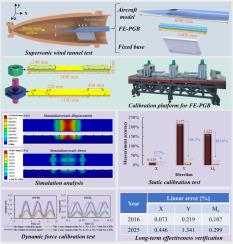2400mm密封压电天平的可行性及性能研究
IF 9.4
1区 工程技术
Q1 ENGINEERING, MECHANICAL
International Journal of Mechanical Sciences
Pub Date : 2025-09-21
DOI:10.1016/j.ijmecsci.2025.110862
引用次数: 0
摘要
为解决高超声速风洞试验中直接测量大、重型飞机模型气动载荷的技术难题,研制了满足大型飞机模型气动测量要求的2400 mm密封压电计衡。压电式应变计天平由两组力敏元件(共8组)组成,采用密封结构保护力敏元件,避免环境破坏,克服了传统应变计天平刚度不足、易受温度干扰等问题。2400mm的大尺寸填补了同类规秤的研究空白。基于压电效应,设计了由8个三分量压电传感器组成的量规平衡结构,并建立了压电系数矩阵。通过仿真分析,对压电表天平的结构强度进行了评估。搭建了校准平台,进行了静态和动态校准,分析了线性误差、可重复性和通道间干扰等性能。通过去耦矩阵补偿,通道间干扰降低幅度可达96.15%。解耦后的阻力、升力和俯仰力矩方向测量误差分别为0.015%、0.140%和0.065%,最大改善效果达到106.5%。进行了长期有效性验证,并在9年后重新校准了计衡的寿命,证明压电计衡具有长期有效性。提出了一种大型密封压电测量方案,为大型飞机模型的风洞力测量提供了新的思路;验证了压电表天平在大型场景下的可行性和长期稳定性,为相关设备的开发提供了技术参考。本文章由计算机程序翻译,如有差异,请以英文原文为准。

Feasibility and performance study of 2400 mm sealed piezoelectric balance
To address the technical challenge of directly measuring the aerodynamic loads of large-sized and heavy aircraft models in hypersonic wind tunnel tests, this paper has developed a 2400 mm sealed piezoelectric gauge balance to meet the aerodynamic measurement requirements of large aircraft models. The piezoelectric gauge balance consists of two groups of force-sensitive elements (a total of 8), and adopts a sealed structure to protect the force-sensitive elements and avoid environmental damage, overcoming the problems of insufficient stiffness and susceptibility to temperature interference in traditional strain gauge balances. The 2400 mm large size fills the research gap of similar gauge balances. Based on the piezoelectric effect, a gauge balance structure composed of 8 three-component piezoelectric sensors is designed, and a piezoelectric coefficient matrix is established. Through simulation analysis, the structural strength of the piezoelectric gauge balance is evaluated. A calibration platform is built, and static and dynamic calibrations are carried out, analyzing performance such as linear error, repeatability, and inter-channel interference. Through decoupling matrix compensation, the inter-channel interference is reduced by up to 96.15 %. The measurement errors of the decoupled drag, lift and pitch moment directions are 0.015 %, 0.140 % and 0.065 %, respectively, and the maximum improvement effect reaches 106.5 %. Long-term effectiveness verification is conducted, and the life of the gauge balance is re-calibrated after 9 years, proving that the piezoelectric gauge balance has long-term effectiveness. A large-sized sealed piezoelectric gauge scheme is proposed, providing a new idea for wind tunnel force measurement of large aircraft models; the feasibility and long-term stability of the piezoelectric gauge balance in large-scale scenarios are verified, providing technical references for the development of related equipment.
求助全文
通过发布文献求助,成功后即可免费获取论文全文。
去求助
来源期刊

International Journal of Mechanical Sciences
工程技术-工程:机械
CiteScore
12.80
自引率
17.80%
发文量
769
审稿时长
19 days
期刊介绍:
The International Journal of Mechanical Sciences (IJMS) serves as a global platform for the publication and dissemination of original research that contributes to a deeper scientific understanding of the fundamental disciplines within mechanical, civil, and material engineering.
The primary focus of IJMS is to showcase innovative and ground-breaking work that utilizes analytical and computational modeling techniques, such as Finite Element Method (FEM), Boundary Element Method (BEM), and mesh-free methods, among others. These modeling methods are applied to diverse fields including rigid-body mechanics (e.g., dynamics, vibration, stability), structural mechanics, metal forming, advanced materials (e.g., metals, composites, cellular, smart) behavior and applications, impact mechanics, strain localization, and other nonlinear effects (e.g., large deflections, plasticity, fracture).
Additionally, IJMS covers the realms of fluid mechanics (both external and internal flows), tribology, thermodynamics, and materials processing. These subjects collectively form the core of the journal's content.
In summary, IJMS provides a prestigious platform for researchers to present their original contributions, shedding light on analytical and computational modeling methods in various areas of mechanical engineering, as well as exploring the behavior and application of advanced materials, fluid mechanics, thermodynamics, and materials processing.
 求助内容:
求助内容: 应助结果提醒方式:
应助结果提醒方式:


